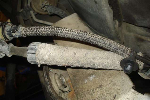bozo4ford
Active Member
- Joined
- February 8, 2010
- Messages
- 55
- Reaction score
- 0
- City, State
- Anaheim, Ca.
- Year, Model & Trim Level
- 1986 Ford Ranger 2.3 4cy
Hi fellow rangers,
[ 1986 Ford Ranger/2.3L gas/5 speed OD/128,745 Miles/ California ]
Ok, This is my "unlucky every other year" SMOG TEST ONLY where I diligently replace my air filter,spark plugs, cap and rotor, (fuel cap, if needed).
The night before doing these changes, I drove to the auto wash stall where I waited for my engine to cool down before spraying Gunk Engine Brite, to clean, to make my work a little more enjoyable, and yes, I did cover the distributor coil, distributor cap, and any other components I did not want to get wet. I was very careful not to use extreme pressure around the aluminum, bendable manifold tubing, which could easily break and water would get down into the engine. I've done the same thing every other year since this SMOG TEST ONLY came into effect without any problems before. (California Emissions)
The day after, I took a drive to the store about a mile away and noticed an extreme stalling where I had to keep gas revved up so it wouldn't stall. I could come to a light signal, and without the gas to the pedal, it would just die. I was really afraid I’d get stuck there.
I don't remember doing anything out of the ordinary this time, except TWO THINGS, (1) the plugs I bought were Autolite Platinum (AP5145) and were supposed to be pre-gapped to .44, and I checked only one, which was fine. and (2) A few days earlier I bought a 12oz. can of OCTANE BOOST gas additive I added to half a gas tank. I know it's bad to use these additives ,but on occasion, I usually go with a fuel injector additive. I am the original owner of this truck, and have been told it's only worth $500.00, so what can I lose, but thinking about it now, these 4-banger trucks don't do good with the higher octane, that's why the REGULAR gas is better than the PREMIUM, Ummmmm....could this be one of the problems? Maybe I should filler up right away to "water down" that octane booster...don't know what the heck I was thinking?????
A few years ago, I did replace my fuel relay switch, and maybe a fuel sensor, but believe me, this truck was running much better before I did all this replacement of the Cap, Rotor, and plugs. The (expensive) spark plug wires I bought two years ago and they looked fine inside each plug wire.
So for the life of me, I don't know where to look, because this could turn out to be a costly and timely process of elimination. Any ideas?
Any would be much appreciated. Thank you! Have a great day!
[ 1986 Ford Ranger/2.3L gas/5 speed OD/128,745 Miles/ California ]
Ok, This is my "unlucky every other year" SMOG TEST ONLY where I diligently replace my air filter,spark plugs, cap and rotor, (fuel cap, if needed).
The night before doing these changes, I drove to the auto wash stall where I waited for my engine to cool down before spraying Gunk Engine Brite, to clean, to make my work a little more enjoyable, and yes, I did cover the distributor coil, distributor cap, and any other components I did not want to get wet. I was very careful not to use extreme pressure around the aluminum, bendable manifold tubing, which could easily break and water would get down into the engine. I've done the same thing every other year since this SMOG TEST ONLY came into effect without any problems before. (California Emissions)
The day after, I took a drive to the store about a mile away and noticed an extreme stalling where I had to keep gas revved up so it wouldn't stall. I could come to a light signal, and without the gas to the pedal, it would just die. I was really afraid I’d get stuck there.
I don't remember doing anything out of the ordinary this time, except TWO THINGS, (1) the plugs I bought were Autolite Platinum (AP5145) and were supposed to be pre-gapped to .44, and I checked only one, which was fine. and (2) A few days earlier I bought a 12oz. can of OCTANE BOOST gas additive I added to half a gas tank. I know it's bad to use these additives ,but on occasion, I usually go with a fuel injector additive. I am the original owner of this truck, and have been told it's only worth $500.00, so what can I lose, but thinking about it now, these 4-banger trucks don't do good with the higher octane, that's why the REGULAR gas is better than the PREMIUM, Ummmmm....could this be one of the problems? Maybe I should filler up right away to "water down" that octane booster...don't know what the heck I was thinking?????
A few years ago, I did replace my fuel relay switch, and maybe a fuel sensor, but believe me, this truck was running much better before I did all this replacement of the Cap, Rotor, and plugs. The (expensive) spark plug wires I bought two years ago and they looked fine inside each plug wire.
So for the life of me, I don't know where to look, because this could turn out to be a costly and timely process of elimination. Any ideas?
Any would be much appreciated. Thank you! Have a great day!










